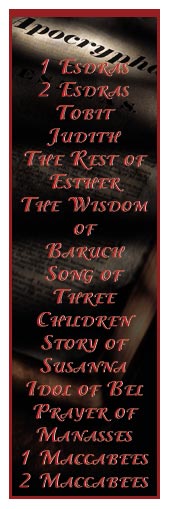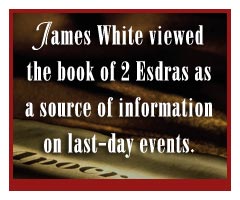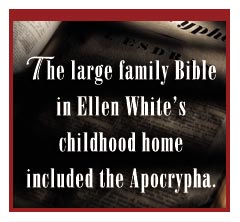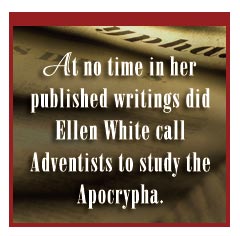BY DENIS FORTIN
 EVENTH-DAY Adventists today, like many other Christians, accept only 66 books in the Old and New Testaments to form what is called the canon of the Bible. These books are considered inspired, authoritative, and reliable for a complete knowledge of the plan of salvation. Other Christians, however, including Roman Catholics and members of the Orthodox churches, include in the canon of the Old Testament from 9 to 15 other books or portions of books. While some call these extra books deuterocanonical (i.e., "a second canon"), Protestants view them as pseudepigraphal and apocryphal (i.e., "falsely entitled or spurious"). Seventh-day Adventists and most Protestants view these books as apocryphal because their alleged authorship is doubtful and because some of their teachings don't harmonize at all with the rest of the Bible. Hence these books are considered as uninspired and aren't accepted as part of the biblical canon.1
EVENTH-DAY Adventists today, like many other Christians, accept only 66 books in the Old and New Testaments to form what is called the canon of the Bible. These books are considered inspired, authoritative, and reliable for a complete knowledge of the plan of salvation. Other Christians, however, including Roman Catholics and members of the Orthodox churches, include in the canon of the Old Testament from 9 to 15 other books or portions of books. While some call these extra books deuterocanonical (i.e., "a second canon"), Protestants view them as pseudepigraphal and apocryphal (i.e., "falsely entitled or spurious"). Seventh-day Adventists and most Protestants view these books as apocryphal because their alleged authorship is doubtful and because some of their teachings don't harmonize at all with the rest of the Bible. Hence these books are considered as uninspired and aren't accepted as part of the biblical canon.1
 The 15 books or portions of books that comprise the Apocrypha contain many kinds of writing. Some convey stories of interesting or exemplary persons (Tobit, Judith, The Song of the Three Holy Children, Story of Susanna). others purport to be lost fragments of canonical books (The Rest of Esther, Bel and the Dragon-additional material for Daniel), while others share similarities with the wisdom literature of the Old Testament (The Wisdom of Solomon, Ecclesiasticus). Prophetic or end-time material is featured in several books (1 and 2 Esdras; Baruch, with the epistle of Jeremiah; the prayer of Manasseh), while some of the history of the Jewish people between the return from Babylonian captivity and the birth of Christ is told in 1 and 2 Maccabees.
The 15 books or portions of books that comprise the Apocrypha contain many kinds of writing. Some convey stories of interesting or exemplary persons (Tobit, Judith, The Song of the Three Holy Children, Story of Susanna). others purport to be lost fragments of canonical books (The Rest of Esther, Bel and the Dragon-additional material for Daniel), while others share similarities with the wisdom literature of the Old Testament (The Wisdom of Solomon, Ecclesiasticus). Prophetic or end-time material is featured in several books (1 and 2 Esdras; Baruch, with the epistle of Jeremiah; the prayer of Manasseh), while some of the history of the Jewish people between the return from Babylonian captivity and the birth of Christ is told in 1 and 2 Maccabees.
Given our current understanding and rejection of the Apocrypha, it comes as a surprise to many Adventists to learn that early Adventists made references to some of these books in their writings. In his 1847 A Word to the "Little Flock," James White included some references to the Apocrypha in his own writings and in footnotes he added to sections written by his wife, Ellen. Furthermore, Ellen White herself mentioned the Apocrypha in the description of a vision she received in January 1850. Why was it that early Adventists alluded to the Apocrypha in their writings? Did Adventist pioneers and Ellen White, in particular, consider the Apocrypha as an inspired part of Scripture?2
The Apocrypha in early Adventism
In the 1830s and 1840s many English Bibles used by Millerites and early Adventists included the Apocrypha. They were included not only in Catholic Bibles, but in Protestant ones as well. It was only in May 1827 that the British and Foreign Bible Society decided to exclude the Apocrypha from its English Bibles. Up to that time it had included them in a separate section between the Old and New Testaments. The large family Bible in Ellen White's childhood home, printed in Boston in 1822 (a replica of which is shown in the cover photo), was one of these Bibles with the apocryphal books inserted between the Old and New Testaments.
It should thus come as no surprise that the apocryphal books were familiar to all English-speaking Christians in the 1840s. Although many Christians didn't consider them as inspired and on the same level as the rest of Scripture, the attitude of the Christian world toward the Apocrypha was different than what it is today. Allusions to, or quotations from, the Apocrypha were neither uncommon nor thought strange because it was believed that much wisdom and even truth could be found in these writings.
This was also the case with many early Adventists who acknowledged that relevant information could be found in them for their study of the Bible. This was particularly true of 2 Esdras, which was the apocryphal book most extensively referred to among early Adventists. Second Esdras is believed to have been written around the end of the first century A.D. It contains a number of visions filled with symbols and apocalyptic prophecies, warnings, and promises that attempt to predict the future and answer some questions regarding God's dealings with his people. One of these end-time visions attracted the attention of early Adventists: the vision of the eagle with three heads, 12 wings, and eight smaller wings (2 Esdras 11:1 to 12:39).3
A Word to the "Little Flock"
In May 1847 James White published a booklet titled A Word to the "Little Flock," in which he included the record of some early visions of his wife, Ellen, and a few remarks from Joseph Bates, another leading Millerite who was keeping the seventh-day Sabbath. This booklet was the first publication to include writings from these three Seventh-day Adventist pioneers. Of particular interest is James White's inclusion of references to 2 Esdras in his article on the seven last plagues (pp. 2, 3), in footnotes he supplied to Ellen White's article "To the Remnant Scattered Abroad," and in her letter of April 7, 1847, to Joseph Bates (pp. 8-20). These references illustrate how early "seventh-day" Adventists (the denomination would not be officially named until 1860), and, in particular, James White, viewed the book of 2 Esdras as a source of information on last-day events.
 In fact, James White's references to 2 Esdras in his article indicate that he had a high view of the reliability of this book. Early in the text of A Word to the "Little Flock" he quotes various texts of Scripture to illustrate the dreadfulness of God's day of wrath. He says, "Ezekiel saw it in the men with 'slaughter-weapons,' slaying 'utterly, old and young.' . . . John saw it in the 'seven last plagues'; while Esdras saw it in the famine, pestilence, and the sword. The Bible contains many descriptions of this soon expected day of wrath."4 James White's association of 2 Esdras with Ezekiel and John and his following comment about the content of the Bible seem to indicate that 2 Esdras had more than casual significance for him.
In fact, James White's references to 2 Esdras in his article indicate that he had a high view of the reliability of this book. Early in the text of A Word to the "Little Flock" he quotes various texts of Scripture to illustrate the dreadfulness of God's day of wrath. He says, "Ezekiel saw it in the men with 'slaughter-weapons,' slaying 'utterly, old and young.' . . . John saw it in the 'seven last plagues'; while Esdras saw it in the famine, pestilence, and the sword. The Bible contains many descriptions of this soon expected day of wrath."4 James White's association of 2 Esdras with Ezekiel and John and his following comment about the content of the Bible seem to indicate that 2 Esdras had more than casual significance for him.
The Apocrypha in the writings of Ellen G. White
But what about Ellen White? How did she use references to the Apocrypha in her writings?
Ellen White's first-ever published writing was a letter she addressed to Enoch Jacobs regarding the contents of her earliest visions. Her letter was published by Jacobs in The Day-Star of January 24, 1846. For many Millerites who were struggling to find light and to understand the meaning of the 1844 disappointment, her visions seemed to be a confirmation of what others were discovering through intense and prayerful Bible study.
The letter published in The Day-Star contained very few direct Scripture references or quotations in the text. It is this letter that James White republished in A Word to the "Little Flock" (pp. 14-18) in 1847. Though the original letters didn't contain many references to Scripture, James White added, in footnotes, a large number of references to support various biblical allusions made by Ellen. Among these references are two taken from 2 Esdras 2.5 James White explained: "The following vision was published in The Day-Star, more than a year ago. By the request of friends, it is republished in this little work, with scripture references, for the benefit of the little flock" (italics supplied).6
In addition, James White also published in the booklet a letter Ellen had written to Joseph Bates in April 1847. To this letter he also added biblical references in footnotes, in which we find four references to 2 Esdras and one to The Wisdom of Solomon.7 Should these references lead us to believe that Ellen White considered the Apocrypha as inspired Scripture?
 A comparison between Ellen White's narrative of her vision in this letter and corresponding Apocrypha references in footnotes shows clear similarities in wording in three cases: the other four references are more elusive.8 While this suggests that Ellen White was likely conscious of the content and wording of 2 Esdras and The Wisdom of Solomon, we have no way of knowing if she directly quoted from them. Like her thousands of other allusions to passages found in the canonical Scripture, these allusions to the Apocrypha may only reflect her familiarity with and interest in these texts found in her Bible. We can't conclude from these allusions that she considered the apocryphal books to be inspired.
A comparison between Ellen White's narrative of her vision in this letter and corresponding Apocrypha references in footnotes shows clear similarities in wording in three cases: the other four references are more elusive.8 While this suggests that Ellen White was likely conscious of the content and wording of 2 Esdras and The Wisdom of Solomon, we have no way of knowing if she directly quoted from them. Like her thousands of other allusions to passages found in the canonical Scripture, these allusions to the Apocrypha may only reflect her familiarity with and interest in these texts found in her Bible. We can't conclude from these allusions that she considered the apocryphal books to be inspired.
What perhaps enlightens us most about these references to the Apocrypha is Ellen White's decision not to include any of them in her subsequent publication of her visions. In 1851, preferring the original appearance of her documents, she republished the narrative of her first visions in The Christian Experience and Views of Ellen G. White (now Early Writings, pp. 11-83) without any footnote references to the Bible or the Apocrypha. This is a clear indication that she didn't want or need these references in her writings and preferred to let the text remain as it was in her original.
Since early Adventists accepted the Bible as an infallible authority, it seems normal that James White would want to buttress his wife's vision narratives with as many Bible references as possible. This would certainly give credibility to her gift of prophecy and to her visions. Since their Bibles included the Apocrypha, Adventist pioneers likely read these books and were familiar with their contents, even more so for those books that have an end-time focus, such as 2 Esdras. James White would naturally give references to the Apocrypha if Ellen White's vision had any allusions to them. It's also possible that many early Adventists may not have known much, if anything, about the debate regarding the inspiration of the Apocrypha or whether its contents should be con-sidered authoritative for faith.
The 1850 vision
On January 26, 1850, while visiting in Oswego, New York, Ellen White received a vision concerning the end-time preparation of God's people. In this vision God revealed to her that some Adventists weren't prepared for Jesus' return because they cared more for their material possessions than making sacrifices for spreading the gospel. Near the end of the record we have of her vision, Ellen White discusses the importance of the Bible and makes an obscure reference to the Apocrypha.
"I then saw the Word of God, pure and unadulterated, and that we must answer for the way we received the truth proclaimed from that Word. I saw that it had been a hammer to break the flinty heart in pieces, and a fire to consume the dross and tin, that the heart might be pure and holy. I saw that the Apocrypha was the hidden book, and that the wise of these last days should understand it. I saw that the Bible was the standard Book, that will judge us at the last day. I saw that heaven would be cheap enough, and that nothing was too dear to sacrifice for Jesus, and that we must give all to enter the kingdom" (italics supplied).9
What did Ellen White mean by "the Apocrypha was the hidden book" and "the wise of these last days should understand it"? This statement is unique and unrepeated in Ellen White's writings, and has puzzled many people. It's difficult to know with any amount of certainty what she really intended by this reference to the Apocrypha.
The immediate context of this statement in the manuscript makes reference to the Bible as the Word of God, pure and unadulterated. She also declares that the Bible is the standard Book that will judge us at the last day. Therefore, it seems that we should try to understand her comment on the Apocrypha in the context of these references to the Bible. Yet it isn't clear whether she somehow identifies the Apocrypha as a part of the Bible, which, as we have already seen, is a plausible explanation, or whether she is contrasting the Apocrypha with the standard as found in the Bible. Is she contrasting the sure "Word of God, pure and unadulterated," with the deficiencies and weaknesses of the "hidden book"? What is it in the "hidden book" that should be understood by "the wise of these last days"? Does she have in mind a particular book of the Apocrypha, such as 2 Esdras, or all the books of the Apocrypha? These questions remain unanswered, but given the early Adventist fascination with 2 Esdras, Ellen White may have been encouraging a study of this book while still upholding the Bible as the unique standard.
 According to her grandson Arthur White, "the full meaning and significance of the E. G. White statement of 1850 is not clearly seen. It should be observed that Ellen White makes no reference to the Apocrypha at any time in her writings in the subsequent 65 years."10
According to her grandson Arthur White, "the full meaning and significance of the E. G. White statement of 1850 is not clearly seen. It should be observed that Ellen White makes no reference to the Apocrypha at any time in her writings in the subsequent 65 years."10
This unusual reference to the Apocrypha becomes even more perplexing when one realizes that it wasn't reproduced by Ellen White in her first publication of this manuscript a few months later. Major portions of this manuscript were reproduced under the title "To the Little Flock" in The Christian Experience and Views of Ellen G. White in 1851 (now in Early Writings, pp. 48-52). A comparison of the handwritten manuscript with the published text reveals that the published account of the vision closely follows the content of manuscript 4, 1850, but the wording isn't identical. Ellen White made some intentional changes when she decided to publish her manuscript. The reference to the Apocrypha quoted above doesn't appear in the middle of page 51 of Early Writings, where it should be after the phrase "the sun at noonday."
Arthur White also raised another issue: the uncertainty regarding the accuracy of our record of this early statement. In a letter to a longtime colleague, W.G.C. Murdoch, at that time dean of the Seventh-day Adventist Theological Seminary, he explained that "there are a number of very uncertain factors in connection with the statement in question. . . . We do not have the statement in what we know to be an absolute authentic E. G. White source. That which is in the file is said to be 'a copy of E. G. White's vision which she had at Oswego, New York.'
"Had this been Ellen White's copy it would not have been so titled. This indicates to us that what we have before us is a copy held by one of our believers, perhaps copied from someone else's copy, but it did help to furnish a part of the record of the early days, and was one of the documents embodied in what we call 'Record Book, Number 1.'"11
The many documents comprising "Record Book, Number 1" were copies of early materials assembled by W. C. White, Ellen White's son, in the 1870s from materials found in earlier record books held by early believers and copies of documents Ellen White had on hand. Assembled before the days of typewriters, the record book is handwritten. At times, the names of those from whom copies were secured were included at the close of the document, but with manuscript 4, 1850, this isn't the case. The title it bears identifies it as some other than a copy made by Ellen White. We have no Ellen White original of this document.12
Conclusion
What are we to make of these few references to the Apocrypha in the writings of Ellen G. White?
The footnote references to the Apocrypha in Ellen White's writings published in A Word to the "Little Flock" were added at her husband's initiative and aren't included in any other publications by Ellen White. These references may indicate that early Adventists gave some credibility to these apocryphal writings found in their Bibles, in particular 2 Esdras, but they didn't necessarily consider them as part of the canon of Scripture.
Ellen White's unique comment about the "hidden book" of the Apocrypha in her vision of January 26, 1850, is unclear, and was never published or commented on in the next 65 years of her ministry. At no subsequent time did she make use of the Apocrypha or call upon Seventh-day Adventists to study the Apocrypha.
If, in the end, we ought to make most of what she made most of, we will return to the necessity of studying-for ourselves-the 66 books of the canonical Scripture. In them, Ellen White said repeatedly, there was light and life, and everything needed to lead us to the Savior.
_________________________
1 Any good Bible dictionary will give the reader further information on the Apocrypha.
2 Document File 31-C-2 in the Ellen G. White Research Center at Andrews University (EGWRC-AU) contains a number of very relevant documents on this subject. It particularly shows how the Ellen White Estate dealt with this issue in the past. I have used many of these documents and borrowed some of their comments for this article.
3 "Under the Triple Eagle: Early Adventist Use of the Apocrypha" (Adventist Heritage 12, no. 1 [Winter 1987]: 25-32), is a good historical study of how Millerites and early Adventists used 2 Esdras in their writings.
4 James White, A Word to the "Little Flock," p. 2.
5 These references are footnote v on page 15, which refers to 2 Esdras 2:43, and footnote ll on page 17, which refers to 2 Esdras 2:19. Another allusion from 2 Esdras 2:47 should have been included in footnote y on page 15 ("Under the Triple Eagle," p. 31).
6 White, p. 13.
7 These references are found on pages 19 and 20 and are 2 Esdras 15:5-27 in footnote M, 2 Esdras 16:68-74 in footnote N, 2 Esdras 6:24 in footnote T, 2 Esdras 15:34, 35 in footnote U, and Wisdom of Solomon 5:1-5 in footnote BB.
8 The overlooked reference to 2 Esdras 2:47 in footnote Y on page 15 also shows clear similarity.
9 Ellen G. White manuscript 4, 1850, in Ellen G. White Manuscript Releases, vol. 16.
10 Arthur L. White, "Ellen G. White and the Apocrypha," Ellen G. White Manuscript Releases, vol. 15, p. 67.
11 Letter of January 20, 1970, EGWRC-AU, File 31-C-2.
12 For more information on this, see the Ellen G. White Trustees document "Ellen G. White and the Apocrypha," Jan. 19, 1970, EGWRC-AU, File 31-C-2.
_________________________
Denis Fortin is an associate professor of theology and associate dean of the Seventh-day Adventist Theological Seminary in Berrien Springs, Michigan.


